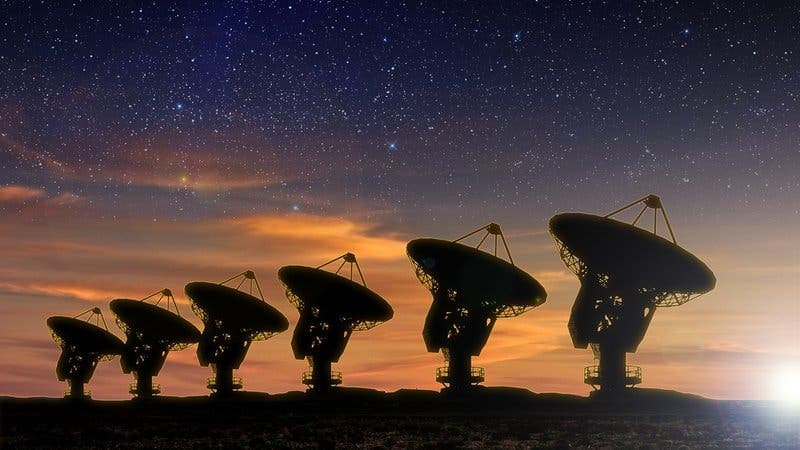Humanity has pondered the existence of alien life for centuries. However, it has been in just the past 100 years or so that modern science has backed some of this thinking. Scientists of the late 1800’s and early 1900’s believed that objects appearing on the surface of Mars were canals constructed by aliens. Particularly, astronomer Percival Lowell believed this concept and promoted it in works such as the book Mars As the Abode of Life (1908).
This belief in the scientific community led to a huge amount of pop culture based around the concept of extraterrestrials. This has resulted in some people even believing in the existence of aliens like the ones in the movies. Who knows? They could be out there. But some wonder how probable their existence is.
With aliens constantly being depicted in entertainment, even after the Martian alien canal hypothesis was busted, scientists considered communicating with otherworldly life forms. The first scientists looking for a close encounter believed the best bet was to use radio waves as the communication medium. The first of such proposed experiments was conducted in 1960 by astronomer Frank Drake.
One of the most eye-opening quotes about extraterrestrial alien life comes from the book Time for the Stars by Alan Lightman. The author states, “Are we alone in the universe? Few questions are more profound… Extraterrestrial contact would forever change the way we view our place in the cosmos” (Lightman 21).
Drake would definitely not be the last scientist to attempt to summon a response from an alien. But this was the first modern example of tests which would now be referred to as part of SETI, the search for extraterrestrial intelligence. In 1980, to bring more of a public interest to SETI, the legendary astrophysicist, astronomer, and astrobiologist Carl Sagan and several others formed The Planetary Society. In more recent years, other programs with goals similar to SETI’s have been established such as METI, messaging extraterrestrial intelligence.
Apart from radio waves, humans have tried other ways of communicating with hypothetical aliens. One example is a plaque which was attached to the Pioneer 10 probe in 1972. This plaque would be a unique kind of “message in a bottle,” except the ocean it was doomed to drift in was far more vast than any sea on Earth. It was inquired of Carl Sagan about sending such a message several months before the scheduled departure of the craft. So Sagan went to work, and assisting him with this undertaking was none other than Frank Drake, the man who had conducted the first modern SETI tests in 1960. The fruit of numerous labors and laborers, the Pioneer 10 plaque that was sent into space depicted a man and a woman and several objects. Through the imagery, the scientists were trying to give any aliens who might see this plaque an idea of what humans are like and where Earth is located.
This could be the first big mistaken researchers are making. They are looking to make contact. They are putting their faith in a sci-fi movie concept. What these scientists are attempting to do is call up and have a conversation with an alien or, better yet, a race of aliens. This is not to say that SETI is pointless, but it might not be the most opportune method for seeking alien life.
Perhaps scientists should strive to discover life in its simpler forms. As Lee Billings of Scientific American states in a recent article, if you were able to travel to another planet it is likely “you would find a planet dominated by microbes rather than charismatic megafauna.” Many scientists are now suggesting microscopic organisms could be more plentiful throughout the cosmos than macroscopic creatures.
A specific search for such minuscule life forms is not a new practice. Bacteria are, of course, microbes. Astrobiologists like Richard Hoover and Dave McKay have examined certain meteorites. Some of the microscopic structures found embedded in or on the space relics resemble bacteria. They have released their findings in past years. They have admitted that even though the fossilized structures appear to be remnants of bacteria there is still some skepticism as to whether those structures are alien in origin. This is because bacteria from Earth could have been attached to the meteorites once they entered our atmosphere.
So how do scientists narrow down the search for alien life even further? Billings’ piece may give us the best idea available at the moment. He informs his readers that one of oxygen’s properties is that it tends to descend from an atmosphere in the form of mineral oxides. It does not remain in its gaseous phase for long. Because of its nature, in an atmosphere such as Earth’s, the oxygen has to be reinstituted on a regular basis.
Astrobiologists have to accept oxygen may be one of the least familiar elements they come upon when studying potential life-supporting bodies. For example, atmospheric chemist David Catling has said the atmosphere of a world dominated by microscopic life could be largely comprised of methane and carbon dioxide gases. Keeping this in mind, this will hopefully narrow down the most likely planet candidates for life.











